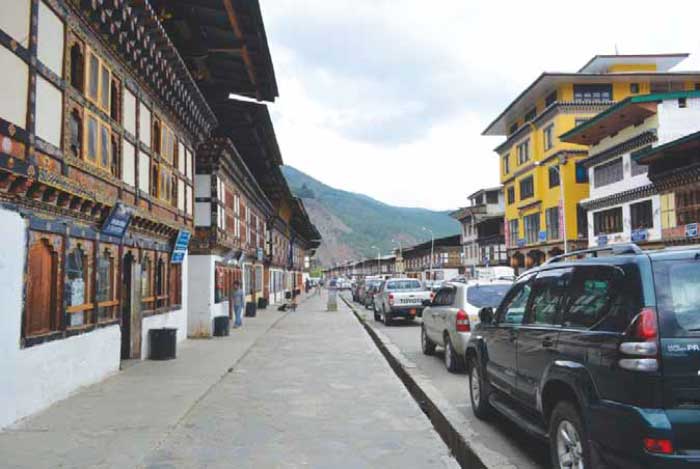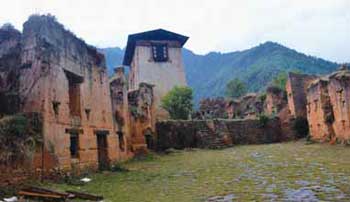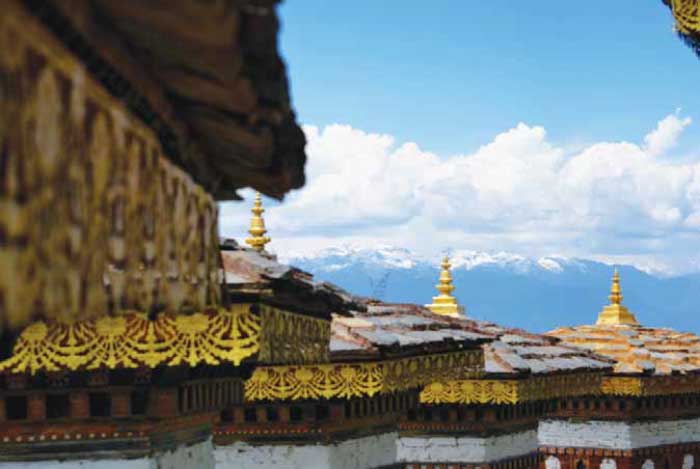With high profile neighbours like China and Pakistan, alongwith others like Sri Lanka, Nepal, Myanmar and Bangladesh, who each have their own unique attractions and moments of excitement on a global scale, it is only after a pause that most people remember the sleepy little country about the size of Switzerland, with who we share a border of 605 kms. Our smallest neighbour and one we share the best ties with – the Kingdom Of Bhutan.

The origin of Bhutan
A possible derivative of the name Bhutan is believed to be from Sanskrit bhoma-anta – a reference to Bhutan’s position at the southernmost extreme of the Tibetan plateau and culture. However, Bhutan is the name which occurs only in English communication. In Bhutanese, which is also known as Dzongkha, the official name of this Buddhist kingdom is Drukyul (country of the Drokpa, the Dragon People, or the Land of the Thunder Dragon), a reference to the country’s dominant Buddhist sect.
Sandwiched between India on three sides (east, south and west) and Tibet in the north, Bhutan is a land-locked country which holds the distinction of being amongst the very, very few countries which have been independent throughout their history, never conquered, occupied, or governed by an outside power (notwithstanding occasional nominal tributary status). The region of Bhutan was a site of numerous warring factions till the early 16th century, when the lama and military leader Shabdrung Namgyal unified the area and created a distinct Bhutanese identity. Bhutan became a protectorate of British India and has since maintained very close relations with India. It was amongst the first to recognise India as an independent country, and signed a Treaty of Friendship with India in 1949, which has since been modified in 1972 and 2007.

Engaging with the world
From actively staying out of contact with the rest of the world, Bhutan from 1952 has aggressively pursued a policy of modernisation. Two major world events are seen as fillips that necessitated this shift in world view. The first was the occupation of Tibet by the Chinese in 1951 which led to Bhutan closing its northern frontiers and aligning
itself more prominently with its southern neighbour. This laid the seeds for Bhutan’s realisation of needing a modernisation programme to offset chances of Chinese encroachment. Later in 1975, its neighbour Sikkim, which had a monarchy that endured more than 300 years, was ousted by a plebiscite, causing this long time Indian protectorate to become India’s twentysecond state. An event that undoubtedly created ripples in the Bhutanese monarchy, and served as an impetus to speed up reform and modernisation. In 2008, Bhutan made the transition from absolute monarchy to constitutional monarchy.

Given its size and location in the Himalayas, it is no surprise that India is Bhutan’s largest trading partner accounting for 98 percent of its exports and 90 percent of imports. This special relationship with India allows for easy access to Bhutan for Indian nationals and vice versa, without need for a visa or passport. Entry can be secured with a voter ID, making it the easiest country for Indians to travel to. A facility, which surprisingly few Indians seem to avail of.
To be fair to the globetrotting Indians, Bhutan is not exactly encouraging of tourism in general. The country was thrown open to tourists only in the 70s, which is when it also became a member of the United Nations. The entry permit allows for travel only to the capital of Thimphu and the town of Paro. To go to any area beyond this, tourists must obtain a special area permit from the Immigration Office at Thimphu.
Travelling to Bhutan
There are three official entry-exit points to Bhutan from India– Phuntsholing, Gelephu and Samdrup Jongkhar in eastern Bhutan. Phuntsholing is about 160 kms from the bustling city of Siliguri in Northern West Bengal. Gelephu is close to Ongaigaon town in Assam and Samdrup Jhonkar is about 150 kms from Guwahati.Of these, Phuntsholing is by far the most easy and popular entry route. Though regulations are favourable, the checking is thorough, methodical and precise.
The only airport is at the town of Paro and Indian citizens can avail of flights at special rates flying out from Kolkata and New Delhi. There are no railways in Bhutan. The first ever railway link connecting India and Bhutan was announced by Prime Minister Manmohan Singh in May 2008. The project – called the Nehru Golden Jubliee Railway Link – was proposed as a 18 km link connecting Hashimara in West Bengal to Toribari in Bhutan. Unfortunately, this meagre rail stretch is stuck in the unending coils of Indian bureaucratic red tape.
Once the formalities are out of the way, being in Bhutan is like entering a peculiar time warp. All modern amenities are available, the roads though limited, are in pristine condition, English is generally understood and yet, it seems like one has entered a different era. The traditional look, feel, language and customs of the Bhutanese are alive and thriving. The years of isolation and regulation of everything foreign has resulted in a modern country which retains the character of the previous century, making the experience akin to entering a fairy tale.
Keeping its traditions alive
Despite the recent surges to integrate with the outside world, the Kingdom of Bhutan is protective of its culture and way of life. It was amongst the last countries to introduce television and internet in 1999. In keeping with this, there are some laws which might seem a little queer but go a long way in maintaining the charm of this kingdom in the clouds. By official decree, all buildings must have the traditional Bhutanese architectural look and it is mandatory to wear the traditional Bhutanese dress for all government employees and all citizens entering government buildings. Vajrayana Buddhism is the official state religion and monks of the order are provided significant government subsidies.
The Tiger’s Nest and sacred mountains
Buddhist monasteries and places of worship along with the forts (dzong) that survive from the medieval ages are the main tourist attractions. The picture postcard for Bhutan tourism, however, is undoubtedly the Tiger’s Nest monastery. Perched, seemingly precariously, on a sheer rock cliff overlooking the Paro valley at an altitude of over 10,000 ft, the Tiger’s Nest monastery is one of those places where history and legend have intermingled so completely that a little bit of each is mixed in the telling of either version.

The protagonist in the story of Tiger’s Nest is the Indian Guru Padmasambhava, also known as Guru Rinpoche, who arrived in Bhutan in the 8th century and established Buddhism in Bhutan and is since seen as the ‘protector saint of Bhutan’. As per the most popular legend, Padmasambhava is said to have arrived here on the back of a flying tigress. He is said to have landed on the cliff, vanquished a local demon, meditated in the cave and anointed it as the place for building a monastery. It is thus that the place came to be known as Taktsang, which means ‘Tiger’s Lair’. Many Tibetan saints and eminent figures have known to have meditated at this location.
One story further embellishes the popular legend with the story of Tenzin Rabgye who built the temple here in 1692, and is mentioned by many authors as a reincarnation of Guru Rinpoche. The current structure however is new as the old one was destroyed in a fire in 2005 along with several centuries of records, paintings, artefacts and statues.
Capital : Thimphu
Size : 38,394 km2
Government : Constitutional Monarchy
Population : 742,737 (2012 estimate)
King : Jigme Khesar Namgyel Wangchuk
Prime Minister : Tshering Tobgay
Currency : Ngultrum
ISD Code : +975
Country Domain : .bt
The true beauty of the world’s last Buddhist Kingdom is its pristine Himalayan landscape and the well preserved biodiversity. Every mountain is sacred, every grove has a mystery and behind every rock is a story of a miracle. Seventy-two percent of Bhutan is under forest cover. Its concern and measures for protecting its natural heritage are considered a model to emulate the world over. It is enshrined in the constitution that 60 percent of the country’s land must be under forest cover, 40 percent designated as national parks, reserves and protected areas, and a further 9 percent as biodiversity corridors linking the protected area. This conservation ideal is at the core of every development policy and buttressed by the force of law.
Controlled tourism
As a Himalayan nation, there is untold potential in mountaineering and related activities. Yet, since 2003, there is a complete ban on any mountaineering in Bhutan. The rationale is a two-fold reasoning which combines the respect for the Bhutanese belief of mountain tops being the sacred home of protective spirits, and the practical problem of the lack of high-altitude rescue resources.
This combination has made Bhutan home to what is widely claimed to be highest unclimbed mountain in the world in terms of elevation – the Gangkhar Puensum (at 24,836 feet). Admirable peculiarities abound in Bhutan. They measure not their Gross Domestic Product, but their Gross National Happiness. It is the world’s only carbon sink – it absorbs more CO2 than it gives out. As a country, it has outlawed tobacco. Its primary export is renewable energy in the form of hydroelectricity which it supplies to India.
Expectations from Bhutan are usually low and information about the shy country is not thrown in your face through advertising. The processes for entry to the country can seem confusing, and the costs of getting there appear disproportionate, as compared to other options of travel in India or the world. Yet, there is a haunting appeal to the place which is not easy to place and on getting here, a strange reluctance to get out of this enchanting kingdom grabs hold. There is a melody to life here. A lilting mesmerising tune which once heard will play itself in your head for a life time.
It may not seem much on a map, but that speck on the globe has an entire world hiding within – a shadow realm of sorts I wish there were more of in this world.


